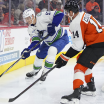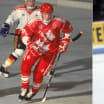It wasn’t long ago when NHL coaches might respond to questions about young players not getting opportunities by saying the NHL was not a development League.
That hasn’t been true for skaters for a while with more skilled forwards and defensemen getting the chance to play in the NHL at younger ages. It’s no longer universally applicable to goalies either and that is a new trend. Though the preference remains for goalies to gain experience in the American Hockey League, more and more are learning on the job in the NHL.
“You see it more with players, but you are starting to see it with goalies as well,” Carolina Hurricanes goaltending coach Paul Schonfelder said. “It feels like goalies are expected to play in the NHL quicker, often after just one or two years in the minors, and not that long ago a goalie prospect could spend 3-4 years in the minors and come in at age 25 or 26. Now it’s 21 to 24 but I still think it’s OK to be patient and let them spend time in the minors to grow and evolve their game.”
Like most things in goaltending, there are no absolutes. Some teams will still go to great lengths to let their young goalies ripen in the AHL, but it’s hard not to notice the rise in the number of goalies getting NHL opportunities earlier in their careers.
The New Jersey Devils, for example, started Akira Schmid in the 2023 Stanley Cup Playoffs after he played 61 games during parts of two seasons in the AHL, and in each of those first two seasons he played NHL games as well. The 23-year-old started this season with the Devils too, playing 15 games before being sent to the AHL in favor of Nico Daws, who is also 23, has played 57 AHL games during parts of three seasons and made his NHL debut with New Jersey on Oct. 23, 2021, as a 20-year-old.


















